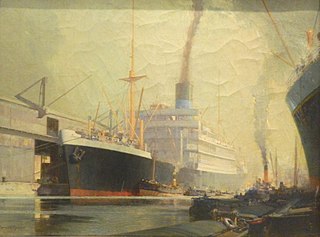
SS Commissaire Ramel was a French cargo liner that was launched in 1920 and sunk in the Indian Ocean by the German auxiliary cruiser Atlantis in World War II.

SS Ceramic was a steam ocean liner built in Belfast for White Star Line in 1912–13 and operated on the Liverpool – Australia route. Ceramic was the largest ship serving the route until P&O introduced RMS Mooltan in 1923.

SS Akaroa was a UK steam ocean liner and refrigerated cargo ship. She was launched in 1914 in Ireland as Euripides for Aberdeen Line. When new, she was the largest ship in the Aberdeen Line fleet.
SS Cambridge was a refrigerated steam cargo liner that was built in Germany for the Hamburg America Line. She was launched in 1916 as Vogtland, but after the 1919 Treaty of Versailles the United Kingdom took her as war reparations and sold her to the Federal Steam Navigation Company, who renamed her Cambridge. She operated between Britain and Australasia until 1940, when a German mine sank her off the coast of Australia.

SS Empire Brigade was a 5,184 GRT cargo ship that was built in 1912 as SS Hannington Court. She served through the First World War and was sold in 1936 to Achille Lauro, who renamed her Elios. In 1940 when Italy declared war on France and the United Kingdom she was interned by the UK as a war prize and taken over by the Ministry of War Transport (MoWT), which renamed her Empire Brigade. Four months later she was torpedoed and sunk by U-99.

SS Sarpedon was a UK steam turbine passenger and refrigerated cargo liner launched in 1923. She was the fourth of six ships to bear the name.
Stirlingshire was a 7,067 GRT refrigerated cargo liner that was built in 1944 by Harland & Wolff Ltd, Belfast, United Kingdom as Empire Falkland for the Ministry of War Transport (MoWT. She was sold into merchant service in 1946 and renamed Stirlingshire. She served until 1966, when she was scrapped.
SS Hertford was a refrigerated cargo steamship that was launched in Germany in 1917, seized by the United Kingdom in 1920 as World War I reparations, and sunk by a U-boat in 1942 with the loss of four members of her crew.

SS Slamat was a Dutch ocean liner of the Rotterdam-based Koninklijke Rotterdamsche Lloyd line. Although she was a turbine steamship, she tended not to be referred to as "TSS". She was built in Vlissingen in the Netherlands in 1924 for liner service between Rotterdam and the Dutch East Indies. In 1940 she was converted into a troop ship. In 1941 she was sunk with great loss of life in the Battle of Greece.
QSMV Dominion Monarch was a UK passenger and refrigerated cargo liner. Her name was a reference to the Dominion of New Zealand. The unusual prefix "QSMV" stood for quadruple-screw motor vessel.

MV E Evangelia is a shipwrecked 7,355-gross register ton (GRT) refrigerated cargo ship at Costinești on the Black Sea coast of Romania. She was built in Northern Ireland in 1942 as the Empire ship Empire Strength, was operated by Blue Star Line from 1942 to 1961, was bought by Greek shipowners in 1965 and wrecked in 1968. The ship had four names in her career, having been renamed Saxon Star in 1946, Redbrook in 1961 and E Evangelia in 1965.

SS Katoomba was a passenger steamship that was built in Ireland 1913, spent most of her career in Australian ownership and was scrapped in Japan in 1959. McIlwraith, McEacharn & Co owned her for more than three decades, including two periods when she was a troopship. In 1946 the Goulandris brothers bought her for their Greek Line and registered her in Panama. In 1949 she was renamed Columbia.

SS Westernland was a transatlantic ocean liner that was launched as Regina in Scotland in 1917, renamed Westernland in 1929 and was scrapped in 1947. She began her career as a troop ship repatriating US troops after the Armistice of 11 November 1918. In the Second World War, Westernland served as a troop ship, repair ship and destroyer depot ship.

MV Waimarama was a UK refrigerated cargo liner. She was built in Northern Ireland for Shaw, Savill & Albion Line and launched in 1938. She carried perishable foods, particularly meat, from New Zealand to the United Kingdom.
SS City of Bedford was a British cargo steamship. She was launched in 1924 in Sunderland for Hall Line Ltd of Liverpool, a member of the Ellerman Lines group.

SS Demosthenes was a UK steam ocean liner and refrigerated cargo ship. She was launched in 1911 in Ireland for Aberdeen Line and scrapped in 1931 in England. In the First World War she was an Allied troop ship.
SS Huntingdon was a refrigerated steam cargo liner that was built in Germany in 1920 as Münsterland. The United Kingdom took her as war reparations and sold her to the Federal Steam Navigation Company, who renamed her Huntingdon. She operated between Britain and Australasia until 1941, when an Italian submarine sank her in the Atlantic Ocean.
SS Algarve was a Danish cargo steamship that was built in 1921 for DFDS. After Germany invaded Denmark in April 1940 Algarve was transferred to the UK Ministry of War Transport. In 1941 an E-boat sank her with all hands in the North Sea.
SS Verdala was a cargo and passenger steamship that was built in Scotland in 1913. Several times she changed owners and was renamed: as Mongolian Prince in 1917, Istok in 1928 and finally Maycrest in 1940.














